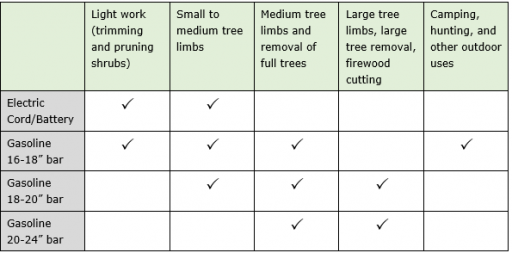Choosing the Right Chainsaw for the Job
June 14, 2018Every project is made easier, and safer, with the right tools. You’d never dream of using an industrial electric drill to add a screw to a delicate piece of furniture. You’d use something smaller that’s more adept to the job. Chainsaws require the same kind of attention. Whether you’re shopping for dad or yourself, we’ve compiled some chainsaw basics and a quick guide to choosing the right model for your ranch, farm, or urban homestead.
The Basics
A standard chainsaw is perfect for trimming limbs, cutting wood, and doing some pruning. A typical chainsaw is simply an engine or motor with front and rear handle attachments along with a bar and chain. The length of the bar equates to the job at hand. The longer the bar, the more industrial the use.
A pole pruner is another type of saw with a specific purpose. These are designed to help you easily cut tree limbs that would otherwise be out of reach.
Both regular chainsaws and pole pruners are available in gasoline and electric models.
Gas vs. Electric
Making the choice between gas and electric chainsaws has become more difficult as electric models have gotten to be far more powerful than their predecessors. If you’re doing medium- to heavy-duty work, a gas-powered model could be ideal. Battery powered as well as corded electric models are excellent for light and medium jobs.
Looking for some negatives to help make your choice? Gas-powered models require that you mix gasoline and oil or buy it pre-made. Battery-powered chainsaws do run out of power eventually and can leave you high and dry unless you have a backup battery. And corded chainsaws are limited to the length of your extension cord.
Power Hungry
Gas-powered chainsaw engines are measured by the cubic centimeters (cc) of air that the engine displaces. The higher the cc, the more powerful the chainsaw. Electric chainsaw power is measured by the electric current being used to power the motor. The higher the ampere (amp) the more powerful the chainsaw. In fact, a 14.5-amp motor can be surprisingly more powerful than a 12-amp model.
Below is a quick chart to help you pick the right chainsaw.

Notice the Features
Chainsaws are often works of mechanical art. Some of the items you’ll notice on today’s models include the following:
- Chain brake: this is a safety item that stops the chain anytime you encounter an abrupt impact.
- Spring-assist starting: this reduces the amount of pull you need to start a gas-powered chainsaw.
- Anti-vibration: makes your saw easier to use and handle over a longer period of time.
- Automatic oiler: if your chainsaw doesn’t have this, you’ll need to manually oil the chain periodically.
- Low-kickback: this helps reduce the possibility of the saw being forced back and up toward the user.
- Quick chain adjustment: this feature allows you to adjust the chain tension to improve cutting.
You’ll Find Dad’s New Chainsaw at Coastal
We carry a full line of gas- and electric-powered chainsaws at your Northwest owned and operated Coastal. Stop by and check out models from Stihl, Husqvarna, and more, including accessories, chains, oil, cases, and people who can help you pick the right model for the job.
Coastal Safety Tips
Keep yourself safe when running your chainsaw with a few simple suggestions.
- Always wear gloves.
- Wear ear protection.
- Safety goggles can protect your eyes from small and large bits of debris.
- Invest in a sturdy pair of work boots to provide good traction and protection.
- Sharpen your chain often. See our favorite sharpeners here.
- Protect your legs by wearing cut-resistant pants
- Wear a hard hat to protect yourself from falling limbs.
